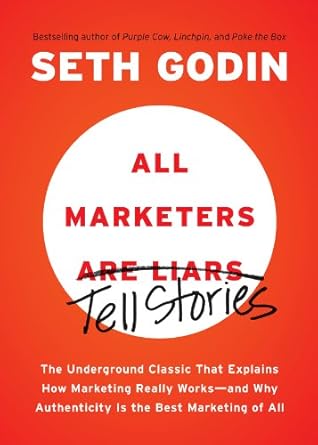More on this book
Community
Kindle Notes & Highlights
by
Seth Godin
Read between
April 11 - June 16, 2017
The public demands that you tell them a story.
Marketing isn’t the problem. Marketing is just a tool. People are the problem. People with short-term pressures and greedy, selfish goals.
A story that works combined with authenticity and minimized side effects builds a brand (and a business) for the ages.
Nuclear weapons have killed a tiny fraction of the number of people that unethical marketing has. It’s time we realized that there may be no more powerful weapon on Earth.
Crafting a story that tricks people into making short-term decisions that they regret in the long run is the worst kind of marketing sin. Refusing to take responsibility for it afterward is just cowardice.
Just because you want to make more money is no justification for using the power of lying to hurt the rest of us.
“If I knew what you know, would I choose to buy what you sell?”
Belief in the lie must not ultimately harm the consumer because if it does, you’ll run out of consumers and credibility far too soon.
Telling people that they’ve believed a lie for a long time is no way to make friends.
Remarkable goods and services help ideas spread—not hype-filled advertising.
once fooled, a person will never repeat your story to someone else.
If you are not authentic, you will get the benefit of just one sale, not a hundred. The cost of your deception is just too high.
Some senses count for more than others, but every sense matters.
You win when you manage to make your story coherent.
Tiny cues that deliver big messages.
Your story is a symphony, not a note.
Because successful stories never offer the things marketers are most likely to feature:
Delivering a remarkable story isn’t easy, but it’s worth it.
you cannot succeed if you try to tell your competition’s story better than they can.
It’s almost impossible to out-yell someone with the same story.
The problem is that once a consumer has bought someone else’s story and believes that lie, persuading the consumer to switch is the same as persuading him to admit he was wrong. And people hate admitting that they’re wrong.
addressing the community of your dominant competitor is going to fail.
You can’t just use any story.
Authentic stories that earn the right to be passed on will be passed on. It’s up to you, the marketer, to earn that right.
The reason so many successful new offerings are run by non-compromising nutcases is that these true-blue storytellers refuse to compromise.
Instead of allowing yourself to be pushed toward the middle, you need to look in the mirror and realize that only a remarkable, authentic story is going to have a chance of spreading.
Your goal should not (must not) be to create a story that is quick, involves no risks and is without controversy. Boredom will not help you grow.
It’s hard to be remarkable when you create artificial boundaries about what you can and cannot do in telling your story.
There are no small stories. Only small marketers.
An ideavirus can rip through a community on a college campus far faster than it can through a New York apartment building of the same size.
If you choose an infertile one, you shouldn’t be the least surprised to discover that your idea doesn’t spread.
You can’t change a person’s worldview easily, but you can take advantage of the opportunity that presents itself when the world changes it for them.
It’s not as easy to change a person’s worldview as it is to change the technology.
Nothing is static. Nothing stays the way it was. And everything you build or design or market is going to change the marketplace.
useful insight for someone with a new idea to market: hook it up to an old story.
There are four reasons why your new release failed: 1. No one noticed it. 2. People noticed it but decided they didn’t want to try it. 3. People tried it but decided not to keep using it. 4. People liked it but didn’t tell their friends.
our default setting is to ignore everything.
Making something a little better doesn’t help you because people won’t bother noticing it.
remarkable ideas are going to get remarked upon—that’s how you grow.
before you can tell a story to someone else, you’ve got to tell one to yourself.
The lie a consumer tells himself is the nucleus at the center of any successful marketing effort.
Fear isn’t rational. That’s what makes it fear, not common sense.
You must have a consistent, authentic story that is framed in terms of the worldview of the person you’re telling the story to. Your story must be robust and honest and transparent and you have to be prepared to live it out loud.


